Ancestors of Jerusha Ryder
December 25, 2021 at 12:16 am , by Alyce Wilson
Like any genealogical document, this is a work in progress. I currently have comments turned off because of some denial of service attacks in 2020. However, you can email me (shantipoet@gmail.com) with any thoughts, questions, or corrections. If you have an account at Ancestry.com, you can also view my family tree, which is public, starting from Jerusha Ryder’s profile. There, you can see the attached documentation.
Jerusha Ryder
Jerusha Ryder (1794-1867), married David Smith and was the mother of Jerusha Ryder Smith (1827-1904), who married Thomas Brownell Wilcox (1821-1908), becoming Jerusha Ryder (Smith) Wilcox. Like the Wilcox line, Jerusha (Ryder) Smith was descended from several old families in Massachusetts, including the founder of Salem and a Mayflower passenger.
The Ryders
John Ryder (1636-1706) m. unknown
The immigrant ancestor of this line, John Ryder, sometimes spelled Rider, was born on December 4, 1636, in Northampton, Northamptonshire, England. According to genealogist James W. Hawes, in a publication printed by the Cape Cod Library of Local History and Genealogy, John was the son of Samuel Ryder, who was also an immigrant in Yarmouth, arriving in 1638, although it’s not known if his family traveled with him. Samuel was a surveyor of highways at Yarmouth in 1649 and in 1653 was appointed lieutenant of the military company at Yarmouth but was later demoted to a common soldier in 1654 for the offense of favoring the Quakers, while some of his company opposed them.
In 1664, John and his wife, whose name has not been recorded, were married. John Ryder was mentioned as surveyor of highways in Yarmouth in 1677. He served on a jury of inquest in 1677 and a grand jury in 1682. John was among the freeman of Yarmouth in 1684. He died on January 5, 1706 in Yarmouth.
John and his wife had the following children: John (1664-1718), Ebenezer (Aft. 1664-1745), Joseph (1671-1766), Lydia (1673-aft. 1702), Hannah (1679-1750), Samuel (1676-1702), and Thankful (1689-1760).
John Ryder (1664-1718) m. Hester Hall (1672-1745)
John Ryder was born on December 3, 1664 in Yarmouth, Mass. On October 23, 1691, in Yarmouth, he married Hester Hall, daughter of John and Priscilla (Bearse) Hall.
John and Hester had the following children: John (1692-1766), daughter (1694, died in infancy), Sarah (1696- Bef. 1772), Bethia (1697-1740), Esther (1699-1752), Mercy (1701-?), Zerviah (1703-1745), Nathaniel (1705-1766), Hannah (1707-?), Thankful (1709-?), and Martha (Abt. 1710-1760).
Nathaniel Ryder (1705-1766) m. Desire Godfrey (1712-1741)
Nathaniel Ryder was born in Yarmouth in June 1705. He was about 14 years old when his father died. Some time after that, he moved to Chatham, along with his brother John and his cousin James Ryder. In Chatham on September 26, 1728, he married Desire Godfrey, the daughter of Moses and Deborah (Cook) Godfrey, who was fifth in line of descent from Stephen Hopkins from the Mayflower. Theirs was the first marriage recorded in Chatham. In previous documents, I’ve shown that other members of the Wilcox line were descended from this same Mayflower passenger.
Nathaniel and Desire had the following children: Nathaniel (Abt. 1730-?), Esther (Abt. 1731-1801), William (1733-1808), Deborah (Abt. 1735-1809), Josiah (1739-1813), Eunice (Abt. 1741-1808), Moses (1742-1769), Jonathan (1744-1787), Desire (1747-1808), Samuel (Abt. 1750-1815), and Zerviah (1752-1808).
Josiah Ryder (1739-1813) m. Huldah Gross (1745-1822)
Josiah Ryder was born in 1739 in Chatham, Mass., which is where he lived until his death on September 28, 1813. He married Huldah Gross in Wellfleet, Mass., on March 13, 1765, the daughter of Hincks and Abigail (Crowell) Gross.
Josiah and Huldah had the following children: Mercy (1765-1841), Stephen (1768-1820), Thacher (1770-1824), Richard (Abt. 1771-1860), Nancy (1772-?), John (1772-1855), Jerusha Emery (1774-1853), Sabrina (1776-1850), Josiah (1778-1835), Huldah (1779-1864), Elisabeth (Abt. 1784-1865), Nathaniel (1785-?), and Rebecca (1794-).
Stephen Ryder (1768-1820) m. Bathsheba Nickerson (1774-1837)
Stephen Ryder was born on February 23, 1768 in Chatham, Mass. On December 2, 1792, in Yarmouth, Mass., he married Bathsheba Nickerson, daughter of Capt. James and Keziah (Godfrey) Nickerson. He died in October 16, 1820 in Chatham.
Stephen and Bathsheba had the following children: Jerusha (1794-1867), James (1795-1845), Samuel (1797-1862), Nehemiah (1799-1840), Stephen (1801-1840), Elijah (1803-1876), Gilbert (1805-1847), Lucretia (1809-1837), Jeptha Godfrey (1811-1839) and Washington (1815-1876).
John Barnes of Plymouth
For the ancestry of Hannah “Anne” Barnes, who married John Ryder, the immigrant, records only go back as her father, John Barnes, an English immigrant who lived out his life in Plymouth, Massachusetts, from 1633-1671. The following details come from a well-researched and footnoted piece, “John Barnes of Plymouth: A Short Biographical Profile,” by Trish Scott and Chip Cunningham, for the Plymouth Colony Archive Project, published by the University of Virginia in the summer of 1996.
Barnes, who was born in England in around 1610, arrived in Plymouth Colony sometime prior to 1633. He married Mary Plummer on September 12, 1633 in Plymouth Colony. She died 18 years later, by June 2, 1651. By 1653, John had married Joan, but no records have been found that provide her maiden name or origin. The Plymouth records mention only two children both to Barnes and Mary Plummer: Lydia, who was born in 1647, and John, who died in 1648. A real-estate record from 1651 mentions Lydia along with another son, Jonathan, and two other daughters, named Mary and Hannah, who would grow up and marry the English immigrant John Ryder.
According to records, Barnes was a merchant, part of a chain that moved goods between Plymouth, Boston and England. He earned his living through cattle, raising crops, and through owning, trading with, and at times selling boats, as well as through various land deals, making him fairly well off financially.
The records show other interesting details about his life. On two occasions, he was fined for drinking after spending time with Gyles Rickard Sr. He sometimes employed servants, including indentured servants, including a negro woman who may be assumed to have been a slave, though they were rare in the colony.
In 1642, Barnes was appointed Constable for Plymouth, along with Thomas Southwood, an important position in the town. The position of Constable at the time included attendance of “the General Court and the Court of Assistants, to act as keeper of the jail, to execute punishment, to give warnings of such marriages as shall be approved by authority, to seal weights and measures, and measure out such land as shall be ordered by the governor or government.”
He was appointed Supervisor of the Highways for Plymouth in 1647 and reappointed the following year. He held the position again 15 years later in 1664 and once more in 1667. Barnes also served on five juries in 1637/1638.
Between 1640 and 1667, he sued people for damages at least nineteen times and was sued in turn by three people. He won 14 of the 19 cases, three were resolved or withdrawn without costs, and he lost two. Lawsuits such as these were not an unusual way to resolve disputes in the colony.
His worst legal troubles all related to drinking, a period of heavy drinking following the death of his wife, Mary Plummer, in June 1651. During this period, he lost his license to sell beer to Plymouth residents, by a June 1659 notice, stating he was being disenfranchised “for his frequent and abominable” drinking.
In June 1661, the ordinary keepers of Plymouth were prohibited from letting Barnes have any liquors, wine, strong drink, at any time, indoors or out.
On March 5, 1671, he was killed after being suddenly attacked by one of his bulls, which he had been petting in front of his barn.
The Halls
Hester Hall, who married John Hall Jr., son of the immigrant, was the daughter of John and Priscilla (Bearse) Hall. Hester was born in Yarmouth, Massachusetts, where she lived her entire life until her death in 1745.
John Hall (1611-1696) m. Bethia Farmer (? – 1683)
The elder John Hall was born in England, possibly Coventry in Warwickshire. By 1630, he emigrated to Massachusetts, settling first in Boston. In 1632, he moved first to Charlestown, in 1640 to Barnstable and by 1653 to Yarmouth, Massachusetts, where he died on July 23, 1696. He married Bethia Farmer, the daughter of John and Isabella (Burbage) Farmer of Armley, Warwickshire, England.
He held various offices, including Barnstable constable, Yarmouth surveyor of highways, and Plymouth grand jury. John held thirty-five acres of farm land.
John and Bethia had the following children: Samuel (1635-1694), John (1638-1710), Shebar (1639-1650), Joseph (1642-1716), Benjamin (1644, died in infancy), Nathaniel (1645-1689), Gershom (1648-1732), William (1651-1727), Benjamin (1653-1737), and Elisha (1655-1747).
John Hall (1638-1710) m. Priscilla Bearse (1643-1712)
John Hall was born on May 13, 1638, in Charlestown, Suffolk County, Massachusetts. In 1660, in Yarmouth, he married Priscilla Bearse, who was born on March 10, 1643. He was a deacon in the church. John Hall died on October 14, 1710, in Yarmouth. Priscilla outlived him for just a short while, dying on March 30, 1712.
Priscilla Bearse is believed by many researchers to be the daughter of Augustine “Austin” Bearse (see below).
John and Priscilla had the following children: John (Abt. 1661-1734), Joseph (1663-1737), Bethia (Abt. 1666-1708), Priscilla (1668, stillborn), Samuel (Abt. 1668-1737), another Priscilla (1671-1724), Hester (1672-1745), Mary (1673-1728), Martha (1676-1734), Nathaniel (1678-1733), Hannah (1682-1753), and Experience (1683-1711).
Augustine Bearse
Augustine Bearse (1618-1686) m. Mary Hayanno
Augustine Bearse arrived on the ship Confidence in 1638, aged 20 and came to Barnstable in 1639. In that same year, Augustine married Mary, believed by some researchers to be Mary “Little Dove” of the Wampanoag Tribe.
Undisputed facts about Augustine include his arrival on the ship Confidence, and his arrival in the Plymouth Colony on April 24, 1638. Goodman Bearse lived in Barnstable and was a farmer. Some of the land he owned is still named after him (Bearse’s Islands), and all of his children’s baptisms were recorded by the church very soon after their births, as he was a model church member.
The rest of the story falls into the realm of conjecture or legend. According to a notarized paper filed by a descendant of Augustine’s, a diary from a granddaughter, which unfortunately no longer exists, told the story of Augustine and Mary Hyanno. The diary stated that Augustine had been a member of the Romany people, his surname originally spelled Be Arce, and that he came to the colonies after having been forced to emigrate due to an unnamed misdemeanor offense. According to this reported account, Augustine was originally from Longstock, Hampshire, England, his father was Gauche Eleazer BeArce, and his mother was Princess Rebecca Matchowich/Matchowitch. No birth records, however, have been found.
According to diary’s account, upon arrival in the colony, Augustine met and married Mary in a ceremony among the Wampanoag, also known as the “white Indians,” who were light-skinned and presumed to have had previous relationships with Vikings who had arrived in the New World. Mary is remembered as having “flaming hair,” presumed to be red.
Some later genealogists have thrown doubt upon this family story, in the absence of an existing paper trail. But the likelihood of a man of Romany origin having ready options to marry amongst the English settlers is somewhat low, especially as many of them would already have been involved in relationships with other locals. So the idea that he would marry a woman of Native origin does make sense, as does the fact that his land lay on the border with Native lands, which would have provided him opportunity to intermingle. A Romany origin for Augustine may also explain why he was such an exemplary church member and why he never fell into dispute with other neighbors, because he would have presumably tried very hard to fit in with the English settlers. This is presumably also why he was able to easily buy so much land from the Wampanoag tribe, as he would have had connections to them through his wife.
In all likelihood, this legend is the origin of family stories about Native heritage within the Wilcox line, especially the family joke that their ancestors traveled across the ocean from England and met themselves.
Mary Hyanno was the daughter of John Hyanno/Iyanough, a Mattachee Sagamore (or leader) and son of Sachem Ihyannough, who reportedly greeted Pilgrims warmly upon arrival. This means the descendants of Jerusha Ryder, through this connection as well as one we’ll discuss later, are descended from both the Mayflower passengers and the Native people who helped them to survive.
Other researchers have found the following about Mary Hyanno. She was the daughter of John Hyanno, who was born in 1595 at the Mattachee Village at what is now Barnstable, Massachusetts, and Mary No-Pee, who was born at Gays Head on Martha’s Vineyard and was the daughter of No-Took-Seet. John was the son of Iyannough, the sachem of the Mattachee village of Wampanoags of Cape Cod, and Princess Canonicus. He died after 1680 on Cape Cod. Princess Canonicus was the daughter of Canochet (Chief) Canonicus, who was one of the Natives who formed a deal with Roger Williams for Rhode Island, and Posh-Pw. Canochet Canonicus was the son of Wessonsuoum and Keshechoo. Wessonsuoum was the son of Chief Tashtassuck, who was born before 1520.
Augustine and his wife Mary had the following children, whose baptisms were all recorded: Mary (1640-1694), Martha (1642-?), Priscilla (1643-1712), Sarah (1646-1712) , Abigail (1647-1670), Hannah (1649-1719), Joseph (1651-1727/28), Hester (1653-?), Lydia (Abt. 1655-1710), Rebecca (1657-?), and James (1660-1728).
The Farmers
Bethia Farmer, who married the immigrant John Hall, was the daughter of John Farmer and Isabelle Burbage. Her lineage can be traced back several generations further, thanks to being members of the England nobility. The entries that go the furthest back come from information within the genealogical document, “The George Washington Farmer Jr. Family: His Ancestors and Descendants” by Elizabeth Ann Farmer (2005), which was shared on the family tree project FamilySearch.org by the author.
According to Elizabeth Ann Farmer (hereafter referred to as “EAF”), the surname Farmer was first recognized in the late 1200s, along with its variant Fermor. Originally, the word “farmer” designated not the people who worked the land but the wealthy landowners who oversaw land leases to the peasants who actually worked the fields.
In EAF’s manuscript, she writes:
The earliest traced and confirmed records show our family line beginning in 1410 with Henry Richards of Langford, Oxfordshire. […] Henry’s father was probably Thomas Richards. Richards was a variation on the old German surname Ricard which meant the family had the characteristic of being powerful and brave. It was brought to England after the 1066 conquest of Normandy (in today’s northern France).
Henry Richards was a woolsman by trade. He obviously did not find his surname as socially prestigious as his wife’s so he took hers as his alias. Henry married Agnes Fermor of Witney, Oxfordshire before 1440. The family lived in Langford, where Henry died in October of 1467 and Agnes died on March 3, 1464.
Henry Richard Fermore (1375-1465) m. Agnes Fermor (1426-1464)
Henry Richard Fermore was born in 1375 in Witney, Oxfordshire, England and was reportedly the son of a Thomas Richard Fermor and Agnes. He married Agnes Fermor, the daughter of a knight, Sir Robert Langford, and the heiress of Langford Belfordshire Witney. The two had at least one son: Thomas.
Thomas Fermor (Abt. 1440-1485) m. Alice Norman (?) (1445-1485)
Thomas Fermor was born in about 1440 in Oxfordshire, England. He married Alice Norman (?). According to EAF, “Thomas became the Mercer of the Staple of Calais.” A mercer was a dealer in textile fabrics, especially silks, velvets, and other fine materials. In the Medieval system, “staple” refers to the system of trade. Calais was a center of trade for raw wool and was then under English control, having been established by King Edward to centralize wool purchases for England from throughout Europe. Because of his position, Thomas had a monopoly on wool sales in England, making him rich and powerful.
Thomas died on September 14, 1485 and was buried in St. Mary the Virgin Church, Witney, Oxordshire.
Thomas and Alice had at least one son, John.
John Farmer (1470-1521) m. Alice Smythe (1479-1521)
John Farmer was born in 1470 in England and married Alice Smythe in 1500. John was a wool merchant like his father, according to EAF. While little is known about him, he must have done well, because he added the title of Esquire to his name. EAF writes, “Esquire was a title won by English gentry for heroism in battle or awarded by the King for persons that were knighted for service to the Crown.” He died in 1521 in Sheepy Magna, Leicestershire, England.
John and Alice had at least three sons: John, Bartholomew, and Thomas.
Bartholomew Farmer (1498-1581) m. Margerie Farmer (1490-1581)
Bartholomew Farmer was born about 1498 in England and married Margerie Farmer, daughter of Ralph and Elizabeth (Samuel) Farmer, in 1519. He died in May 1581 in Ratcliffe on the Wreake, Leicestershire, England.
Bartholomew and Margerie had the following children: Alice (Abt. 1519-Abt. 1581), John (1520-1561), Jone (1521-After 1581), Ralph (1522-Abt. 1585), and Humphrey (1524-Aft. 1585).
Sir John Farmer (1520-1561) m. Elizabeth Bearden (1520-1599)
Sir John Farmer was born in 1520 in Easton, Northamptonshire, England. In 1542, he married Elizabeth Bearden, daughter of John and Margaret (Crawford) Bearden of Whitchurch, Shropshire, England. He became Sir John when he was knighted by Queen Mary. He died on October 2, 1553 in Ratcliffe Cuiley, Leicester, England.
John and Elizabeth had at least six children: Bartholomew (1542-1624), Ralph (1544-1592), Lawrence (1546-), Alexander (Abt. 1550-1605), Richard (1552-1638), and George (1560-1597).
Bartholomew Farmer (1542-1624) m. Ursula Mattes (1546-1609)
Bartholomew Farmer was born in 1542 in Ratcliffe, England. In 1564 in Whitchurch, he married Lady Ursula Mattes, daughter of Robert and Margaret (Matthew) Mattes. He died in 1624 in Ratcliffe Cuiley, England.
Bartholomew and Ursula had the following children: Edward (1569-1650), William (1570-Abt. 1619), Thomas (Abt. 1574-?), Mary (1578-1655), Pease Bethia (1579-1686), Elizabeth (Abt. 1584-?)), and John (1589-1658).
John Farmer (1581-?) m. Isabelle Burbage (1591-?)
John Farmer was born on in 1581 in Leicestershire, England. In about 1611, he married Isabella Burbage. It should be noted there was another John Farmer, from Arnsley in Warwickshire, England, who married an Isabella Burbage, who moved to a different part of Massachusetts, near Boston. Our couple lived in the Cape Cod area, in Barnstable County, and they were about a generation older than the other John Farmer and Isabella Burbage. Some family trees confuse the two couples, but it’s important to remember that their families originated in adjoining counties in England. They may very well have had some family connections to the other couple. Families, for example, often reuse names through many branches and generations.
According to the General Armory of England, Scotland, Ireland and Wales (1884), John received a coat of arms in 1619, described as followed: “Sable (black) on a chevron between three lamps argent (silver) flammant proper a leopard’s face between two mullets gules (red).” (Depicted on page 7 of this document.)
John and Isabella had the following children and possibly others: Bethia (1612-1683).
The Godfreys
Desire Godfrey (1712-1741), who married Nathaniel Ryder, was the daughter of Moses and Deborah (Cooke) Godfrey. Her lineage may trace back to the pilgrim Francis Godfrey, but there is no conclusive proof of this connection.
Francis Godfrey (1590-1669) m. Elizabeth Hall (1601-1702)
Francis Godfrey, the immigrant, arrived in Massachusetts in 1638. Some researchers believe Francis was the father of the George Godfrey who married Hannah (unknown surname) and was the ancestor or Desire Godfrey Ryder. However, no written documentation proves this connection, so it must be considered only a theory.
Francis and Elizabeth’s only documented child was Elizabeth, who married John Cary in June 1644.
George Godfrey (1636-1688) m. Hannah (1640-1688)
George arrived in Eastham, Massachusetts, before 1661. His wife was Hannah, surname unknown. Three of his sons — George Jr., Moses and Jonathan — went to Monomoit between 1686 and 1705, before the name of the town changed to Chatham in 1712. George died in 1688 in Eastham and was buried at Eastham Cove Burying Ground.
George and Hannah had the following children: George (1662-1711), Samuel (1664-?), Moses (1667-1743), Hannah (1669-1725), Mary (1672-1725), Ruth (1675-1757), Richard (1677-1716), Jonathan (1685-1765), and Elizabeth (1688-1717).
Moses Godfrey (1667-1743) m. Deborah Cooke (1678-1745)
Moses Godfrey was born on January 27, 1667, in Eastham, Barnstable County, Mass. In about 1700, he married Deborah Cooke, the daughter of Josiah and Deborah (Hopkins) Cooke. Moses and Deborah were buried in Chatham’s oldest burying ground. After the death of both Moses and his wife, a number of his children moved to Nova Scotia, Canada, in around 1760, including Samuel, Moses, David, and Richard.
According to “The Godfreys of Chatham, MA” by Elizabeth Pearson White of Winnetka, Ill., “Moses was very active in both religious and secular affairs in the community and were among the first to join the Chatham church when it was organized in 1726 but soon disagreed with the Rev. Lord over his attitude toward the freethinking Rev. Samuel Osborne of the Pochet church at Orleans. Moses and Deborah Godfrey, along with Elisha Mayo, were then excommunicated. They immediately rejoined the Pochet church, where they formerly had been members. It was typical of the Godfreys, during the next two hundred years, to be nonconformists in matters of religion, being Baptists, Universalists and non-sectarians, when such views were unpopular.”
He served as a tithingman, fence viewer and surveyor between 1695 and 1705, when he served on a grand jury. In 1710, he served as an assessor.
Moses and Deborah had the following children: Jonathan (1701-1730), Samuel Prince (1703-1768), Moses (1705-1773), George (1707-1768), David (1709-1783), Mary (1711-1782), Desire (1712-1741), Benjamin (1715-1756), Elizabeth (1717-1742), Deborah (1721-Bef. 1763), Joshua (1723-1760) and Richard (1724-1760).
The Cookes
Deborah Cooke, who married Moses Godfrey, was the daughter of Josiah Cooke and Deborah (Hopkins) Cooke and therefore represents a family connection to the Mayflower passenger Giles Hopkins.
Josiah Cooke (Abt. 1610-1673) m. Elizabeth Ring (Abt. 1610-1687)
Josiah, sometimes called Josias, Cooke was born in about 1610. His parents are unknown, though he has sometimes incorrectly been linked to the Pilgrim, Francis Cooke. Josiah married Elizabeth Deane, the widow of Stephen Deane, who was the daughter of the widow Mary Ring.
Josiah was made a freeman in Plymouth in 1636. First, he lived in Plymouth and then in Eastham as of 1658. He was a tavern keeper and was licensed to sell wine at Nauset in 1648. He was active in public affairs, frequently serving on juries. In 1639 he was a highway surveyor. In addition, he served on a committee to purchase land from the Native people on June 5, 1651. Furthermore, he served as Plymouth constable in 1640, was deputy to the General Court from Eastham 14 times between 1647 and 1671, was auditor of the treasurer’s accounts six times between 1658 and 1665, was selectman in Eastham on June 5, 1666 and town clerk there on June 7, 1648. He was authorized to make contracts of marriage and administer oaths in Eastham on June 8, 1664.
Josiah and Elizabeth had the following children: Anna (1636-1656), Bethiah (1640-?), and Josiah (1645-1731).
Josiah Cooke (1645-1731) m. Deborah Hopkins (1648-1686)
Josiah Cooke was born in 1645. He married Deborah Hopkins, daughter of and Hopkins.
Josiah and Deborah had the following children: Elizabeth (1669-1670), Josiah (1670-1727), Richard (1672-1754), Elizabeth (1674-1727), Caleb (1676-1727), Deborah (1678-1745), Joshua (1682-1746), and Benjamin (1686-Aft. 1727).
Mary Ring
Elizabeth Ring’s mother, commonly referred to as “the widow Mary Ring,” is thought by some to have had the maiden name Durrant. The following information comes from a write-up on FindAGrave.com (memorial ID 121469237):
There is a possibility that it was “our” William RING, of the parish Petistree, union of Woodbridge, in the Eastern Division of the County of Suffolk, who married Mary DURRANT at Ufford, Suffolk, on 21 May 1601. Their daughter Elizabeth RING was baptized at Ufford 23 February 1602/3. Ufford, also in the union of Woodbridge, is two and a half miles northeast from the town of Woodbridge. Ufford is in the lowlands along the river Deben which was subject to periodic flooding. “Anciently”, said Lewis in 1842, there was a chapel there called Sogenho, but it no longer exists. The Earls of Suffolk took their name from Ufford. Unfortunately, the dates don’t work out quite right. If Mary was born ca. 1589, she wouldn’t have been married until ca. 1609, and Elizabeth wouldn’t be born until ca. 1610. It is possible that the Elizabeth who was baptised in Ufford may have died young, and a second daughter of the same name may have been born later.
The Rings were among the Separatists who removed to Leiden in 1607 and thereafter. Mary Ring witnessed a betrothal in Leiden in 1614. Although there was great economic hardship for the English Separatists in Holland, at least at first, the Dutch authorities left them alone to worship as they pleased. However, the Dutch government was not so tolerant of its own separatists. Two incidents seemed like portents of unpleasantness to come. On 28 April 1619 a group of some twenty Dutch boys threw stones at 63-year old James CHILTON and his daughter. James was hit on the head and knocked to the ground. It appears that the boys were more exercised about Dutch separatists than foreign ones, but were not too particular who was the butt of their wrath. Then on 15 July 1619 the Dutch government published an edict prohibiting [Dutch] separatist religious gatherings. A final consideration, and perhaps the most persuasive, was the attraction felt by the English teens toward the less-disciplined youthful Dutch. In contrast, the English Separatists tried to maintain a strict Puritan culture for their own young people.
Mary was literate. She could sign her name, and her estate inventory included the following books: a Bible, “Dod.”, Plea for Infants, Ruine of Rome, Troubler of the Church in Amsterdam, Garland’s Of Vertuous Dames, a psalm book, “Pennery”, and one pair hinges, the whole lot valued at 4 shillings.
William Ring was part of the group who decided to emigrate to the new world. He was on the leaky Speedwell when it had to turn back to England in 1620. Stratton suggests he probably returned to Leiden, where he died. Sometime around 1629 his widow Mary and their three children, Elizabeth, Susanna, and Andrew, emigrated to the Plymouth Colony.
If the estimated arrival of Mary Ring and her children in 1629 is correct, then the many web references to Elizabeth Ring’s marriage to Stephen Deane in September 1627 are incorrect. Most reputable sources seem to give 1630 as the year for the marriage of Elizabeth Ring and Stephen Deane.
Mary died 15 or 19 July 1631 in Plymouth. Her estate inventory lists clothing and fabric in interesting colors: black, gray, red, blue, violet, white, and green (hardly the dull shades stereotypically assigned to Puritans). The inventory also showed her to be a savvy businesswoman; the Governor owed her £2, and she was due another £2 of commodities “to come out of England”. She was owed 6 shillings worth of beaver from Mr. Wynslow [sic] that she explained as resulting from “timber that I lent [him] that cost me a pound of beaver, besides a piece more than they took of me”, and money from Goodman Gyles. Since there were no banks, and specie was notoriously scarce, people borrowed from each other. These accounts in her estate inventory indicate that Mary was an active player in the economic and financial life of Plymouth.
Mary died after the marriage of her two (surviving) daughters, and the birth (or expected arrival) of a grandchild. Her son Andrew Ring, however, was still a minor. As it was assumed that husbands would take care of their wives, Mary assigned most of her goods to her son, stipulating that her son-in-law Stephen Deane would play a large role in caring for the boy. She required Stephen “to help him forward in the knowledge & fear of God, not to oppress him by any burdens but to tender him as he will answer to God.” As overseers she named two men, “loving friends”, who had been in the Leiden congregation, Samuel FULLER and Thomas BLOSSOM.
The Hopkins Family
Deborah Hopkins was born on June 15, 1648 in Eastham, Barnstable County, Massachusetts. She was the daughter of Catherine (Weldon) and Giles Hopkins. Her father, Giles Hopkins, was a Mayflower passenger, along with his father, Stephen Hopkins. On July 27, 1668, Deborah married Josiah Cooke, son of Elizabeth (Ring) and Josiah Cooke.
Deborah’s oldest sister, Mary (1640-1700), who married Samuel Smith, were direct ancestors of David Smith, who married Jerusha Ryder, meaning they were both descended from Giles Hopkins. Because of the number of generations between them and Giles Hopkins (six on David’s side, five on Jerusha’s), their connection is very distant: fourth cousins, once removed. I have previously written more about Giles and Stephen Hopkins in the document, “Mayflower Ancestors,” completed May 4, 2020.
The Grosses
Huldah Gross (1745-1822), who married Josiah Ryder (1739-1813), was the daughter of Abigail (Crowell) and Hincks Gross. The Gross family can be traced back several generations to Isaac Gross, the immigrant.
Isaac Gross (1585-1649) m. Mary Howard (1591-1672)
Isaac Gross was born November 19, 1585, in Kelsagh, County Suffolk, England, the son of William and Margery (Candle) Gross. With his wife and children, he came to Boston before 1635. His brother Edmund came over shortly afterwards.
First, in England, he married Ann (surname unknown). After their marriage ended, she married a Samuel Sheere/Shears. On August 4, 1658, he married Mary Howard, the daughter of Clement Howard.
Isaac and Mary had the following children: Edmund (1613-1655), Mary (1614-?), Matthew (1615-1652), and Clement (1616-1683).
Clement Gross (1616-1683) m. Mary ?
Clement Gross was the son of Isaac and Mary (Howard) Gross. He was born in England on February 18, 1616, and was still living in Boston by October 10, 1683. Prior to 1635, he accompanied his father to New England. Like him, his occupation was brewer. By 1658, he was a licensed inn-holder, with his license renewed every year up to and including 1678. These licenses were only given to responsible and respected citizens. By 1677, he fell into debt and had to sell his own lands.
He was married twice, first before 1649 to Mary, whose surname is unknown. With Mary he had the following children: Simon (1652-1696), Elizabeth (1653-1656), Edmund (1655, died young), Elizabeth (the second) (1658-?), Thomas (1655-1692), William (1665-?), Clement, Thomas, and Isaac.
Second, he married Ann, whose surname is also unknown, and who died between 1671 and 1676. With Ann he had the following children: Edmund (the second) (1669-1728) and Ann (1671-?).
Simon Gross (1652-1696) m. Mary Bond/Pond (Abt. 1655-?)
Simon Gross was born in about 1652 in Boston. His official birth record has not been found, but many believe he was the son of Clement Gross. Some believe him to be the son of Clement’s brother Edmund, but he is definitely the grandson of the immigrant Isaac. According to “Windeker, Gross and Allied Families” by Esther Gross Windecker (American Historical Co., 1943), “As early as 1675, Simon Gross moved to Hingham, where he was a cordwainer, though sometimes styled ‘boatman.’ He resided on South Street in Hingham. From there he served in King Philip’s War in 1675-76.”
On October 23, 1675, Simon married Mary Bond or Pond. Simon died in 1696 in Hingham, Massachusetts, where he raised his children and is presumably buried.
Simon and Mary had the following children: Simon (1676-1696), Thomas (1678-1728), John (1681-?), Josiah (1683-1717), Micah (1684-1753), Obadiah (1685-?), Alice (1689-?), Abigail (1692-?), Isaac (1701-1742), and one more child whose name is not recorded.
Thomas Gross (1678-1728) m. Elizabeth Hinckes (1692-1708)
Thomas Gross was born in 1678 in Hingham, Plymouth County, Mass. On December 29, 1705, he married Elizabeth Hincks, the daughter of Elizabeth (Fryer) and John Hinckes of Boston. Thomas and his family resided in Hingham, Massachusetts.
Thomas and Elizabeth had only one child, Hincks (1708-1788). Elizabeth died that day in childbirth.
After Elizabeth passed away, Thomas married again on December 29, 1709 to Experience Freeman (1689-1718), a Mayflower descendant. They had the following children: Freeman (1711-1742), Sarah (1713-?), Elizabeth (1716-?), and Thomas (1718-?).
Experience Freeman represents the fourth Mayflower passenger linked to the Wilcox line through a non-biological parental relationship (also including Francis and John Cooke; and Richard Warren). In addition, the Wilcox line are descended from six biological ancestors (John Alden; William and Alice Mullins; Priscilla Mullins; and Stephen and Giles Hopkins). Experience’s link to the Mayflower was as follows:
Rev. William ‘Wil’ Brewster (1566-1644) m. Mary ? (Abt. 1568-?)
William Brewster was born on April 10, 1644 in Scrooby, Nottinghamshire, England. He was a passenger on the Mayflower, along with his sons Love and Wrestling. Because of his education and stature with those immigrating from the Netherlands, William became the ruling elder of the Pilgrim church, which was founded in the Plymouth Colony in 1620. William was also a signer of the Mayflower Compact.
Patience Brewster (Abt. 1600-1634) m. Gov. Rev. Thomas Prence (1600-1673)
Patience Brewster was born most likely in Scrooby, England, to Elder William Brewster and Mary (maiden name unknown). Her birth date is estimated to be between 1595 and 1603. She arrived in Plymouth aboard the ship Anne in 1623 with her sister, Fear. Her parents, along with her brothers Love and Wrestling, arrived in 1620 on the Mayflower. Her other brother, Jonathan, arrived with her future husband, Thomas Prence, on the ship Fortune. On August 5, 1624, she married Thomas Prence, who became the fourth governor of the colony on January 1, 1634. Together, they had four children: Rebecca, Thomas, Hannah and Mercy. Patience died in 1634 of a “pestilent fever.”
Mercy Prence (1631-1711) m. John Freeman (1626-1719)
Mercy Prence was born in June 1531 in Plymouth. On February 14, 1649, she married John Freeman, who was born in England and came to New England with his father in 1635. John was prominent in the affairs in Eastham, Mass., being one of the planters of the town, and a deacon in the church for many years. He was a major in the militia and saw service in the Indian wars and was also a member of the Court of Common Pleas.
Edmund Freeman (1657-Abt. 1717) m. Sarah Mayo (1660-1745)
In January 1677, he married Ruth Merrick, who died in 1680, the couple having no recorded children together. Second, he married Sarah Mayo in 1681/82. They had 12 children together: Isaac, Ebenezer, Edmond, Ruth, Sarah, Mary, Experience, Mercy, Thankful, Elizabeth, Hannah, and Rachel.
Experience Freeman (1689-1718)
Hincks Gross (1708-1788) m. Abigail Crowell (1715-1756)
Hincks Gross was born on June 7, 1708 in Hingham, Plymouth County, Mass. On July 25, 1731, he married Abigail Crowell, the daughter of John and Alice (Gross) Crowell. She predeceased him in 1756. On January 27, 1756, he married Bethiah (Arey) Rich, daughter of Richard and Lidia (Norton) Arey and the widow of Samuel Rich.
Hincks and Abigail shared a set of grandparents in Simon Gross and Mary Pond/Bond, making them first cousins. Thomas, the father of Hincks, was the brother of Alice, who was Abigail’s mother.
Hincks and Abigail had the following children: Elizabeth (1735-1813), Alice (1737-1810), Thomas Hincks (1740-1817), Hannah (Abt. 1741-1822), Jabez (1743-1819), Huldah (Abt. 1745-1822), Abigail (1748-1756), Sarah (1749-1816), and Azubah (Abt. 1754-1820).
The Hinckes Family
Elizabeth Hinckes, who married Thomas Gross, was the daughter of John and Elizabeth (Fryer) Hinckes. Her family can be traced back a few additional generations.
Thomas Hinckes (1614-1669) m. Barbara Baker (1618-1658)
Thomas Hinckes was born on December 7, 1614 in Tettenhall, Staffordshire, England. On September 10, 1639, he married Barbara Baker, also in Tettenhall. He died in about 1669 in Tettenhall.
Thomas and Barbara had the following children: Jacobus (1640-?), Barbara (1641-?), Thomas (1645-1693), Samuel (1646-?), Josephus (1651-?), Elizabetha (1654-?), Peter (1655-Abt. 1747), and Sarah (1658-?).
John Hinckes (1649-1734) m. Elizabeth Fryer (1657-1720)
John Hinckes was born in 1649 in Tettenhall, England, coming to Boston around 1670. In 1678, he married Elizabeth Fryer, daughter of Judge Nathaniel and wife Christian (Scarlett) Fryer in Newcastle, Rockingham County, New Hampshire. Elizabeth had also been born in Boston. He died in April 1734 in Portsmouth, New Hampshire. Elizabeth died in 1720 in Newcastle, New Hampshire.
In New Hampshire, John was a person of standing, being appointed the chief justice of the superior court of New Hampshire. He remained in office as councilor, chief justice, and captain of the king’s fort, until 1707.
John and Elizabeth had the following children: Sarah (1675-1754), Samuel (1680-1758), Mary (1689-1744), Elizabeth (1692-1708), Barbara, and Christian.
The Fryers
James Fryer (1598-1640) m. Catherine Davenport (1602-1640)
James Fryer was born in 1598 in County Suffolk in England. He is believed to be the son of Thomas and Elizabeth Merritt (Hall) Friar/Fryer. James and his wife, Catherine Davenport (parents unknown), were the immigrants to New England from this line. They married in 1624 in England.
James and Catherine had the following children: Nathaniel (1624-1705), Wilmet (1643-1661), Joshua (?-1704),
Nathaniel Fryer (1624-1705) m. Christian Allison Scarlett (1625-1679)
Nathaniel was born in about 1624. He was an early settler of Strawbery Banke, which became Greenland and later Portsmouth. In 1652, he married Christian Allison Scarlet, the daughter of John and Ann (Grafton) Scarlett, and bought land in Boston in 1653. Nathaniel received a coat of arms, which was a round seal with a very clearly cut antique head. After the death of his wife, Christian, in 1679, he married, second, Dorothy Woodbridge in Newbury, Mass.
For many years, he resided in Newcastle, New Hampshire. He served as a treasurer, commissioner, a captain of the militia and was an active businessman. Nathaniel died on August 13, 1705 in Newcastle, New Hampshire.
Nathaniel and Christian had the following children: James (1653-), Sarah (1656), Elizabeth (1657), Nathaniel (1660).
The Crowells
Abigail Crowell, who married Hincks Gross, can also be traced back a few further generations. Abigail was born on June 3, 1715 in Chatham, Mass., the daughter of John and Alice (Gross) Crowell. As mentioned above, Alice Gross was the sister of Thomas Gross, who was the father of Hincks, making the couple first cousins.
John Crowell/Crowe (Abt. 1590-After. 1651) m. Elishua Yelverton (?) (1602-1688)
John Crowell was born in about 1590 in England. By about 1615, he married — possibly Elishua (possible surname Yelverton) of Devonshire, England — and came to the colonies with his family. His wife arrived in 1634, buying a house from William Jennings, and then John arrived in 1635. Because of the gap between his first two children and the rest of his children, the possibility exists that he was married twice and that Yelverton and Elizabeth were the children of the first wife, while the rest were the children of Elishua.
John died soon after March 2, 1651, the last time his name appears in a document.
John and Elishua had the following children: Yelverton (Abt. 1615-1683), Elizabeth (1617-1696), John (Abt. 1635-1689), Moses (1637-1688), and Thomas (1645-1690).
Yelverton Crowell/Crowe (Abt. 1616-1683) m. Elizabeth Hammond (Abt.1620-1703)
Yelverton Crowell, sometimes referred to as Crowe, was born in about 1616 in Carltonrode, Norfolk, England. He came to Plymouth, Mass., and settled in Yarmouth in 1640. In 1646, Yelverton served as a surveyor of highways in Yarmouth. In 1647, he married Elizabeth Hammond in Yarmouth, Mass. He died suddenly on October 24, 1683 in Yarmouth.
Yelverton and Elizabeth had the following children: John (1642-1731), Edward (1644-1688), Samuel (1646-1723), Thomas (1649-1722), Elizabeth (twin of Thomas) (1649-1708), Yelverton (1651-1683), and Mary (1653-1727).
John Crowell (1642-1731) m. Hannah ? (Abt. 1661-1753)
John was born in 1642 in Yarmouth. In 1680, he married Hannah, surname unknown. John served in a war against the native people in 1675. He died on February 28, 1731 in West Yarmouth. His wife, Hannah, died on October 5, 1753.
John and Hannah had the following children: Susannah (1591-1687), Elizabeth (1682-1707), Jabez (1683-1727), Deliverance (1684-1737), Hannah (1687-1751), John (1689=1746), Experience (1694-1777), Joseph (1696-1783), Mary (1698-1739), Reliance (1699-1772), Sarah (1700-1772), Mercy (1702-1739), Rachel (1703-1744), and Ephraim (1706-1795).
John Crowell (1689-1746) m. Alice Gross (1689-?)
John was born on December 5, 1689, in Yarmouth, Mass., and married Alice Gross, daughter of Simon and Mary (Bond or Pond) Gross.
John and Alice had the following children: Abigail (1715-1756), Jabez (1717-1800), John (1719-1763), Jonah (1721-?), and Rhoda (1733-?).
The Nickersons
Bathsheba Nickerson (b. December 2, 1774 in Dennis, Barnstable County, Mass.; d. July 1837 in Chatham, Barnstable County, Mass.), who married Stephen Ryder, was the mother of Jerusha (Ryder) Smith. Her ancestry leads to numerous prominent citizens of colonial New England.
Capt. Israel Nickerson (1709-1772) m. Hannah Small (1715-1799)
Israel Nickerson was born on March 31, 1709 in Yarmouth, Barnstable County, Mass. On December 26, 1735, in Harwich, Barnstable County, he married Hannah Small, daughter of Jonathan and Damaris (Winslow) Small, in Harwich.
Israel and Hannah had the following children: Eleazer (1718-1800), Sarah (1741-1847), Israel (1741-1791), James (1744-1815), and Patience (1749-?).
Capt. James Nickerson (1744-1815) m. Keziah Godfrey (1750-1823)
James Nickerson was born on February 17, 1744 in Dennis, Barnstable County, Mass. On January 4, 1770, in Chatham, Barnstable County, Mass., he married Keziah Godfrey, the daughter of Jeptha and Bathsheba (Eldredge) Godfrey. He died on March 4, 1815 in Dennis.
James and Keziah had the following children: James (1770-1818), Jepthah (1772-1825), Patience (1777-1811), Keziah (1780-1870), Sarah (1782-1857), and Elijah (1789-1871).
The Smalls
Hannah Small, who married Capt. Israel Nickerson, can be traced back several generations. Hannah was born on August 20, 1715, and married Capt. Nickerson on March 5, 1736 in Harwich, Barnstable County, Mass. She was the daughter of Jonathan and Damaris (Winslow) Small. Hannah died on March 2, 1799. Earlier generations of her family are as follows.
Edward Sutton Smalle (1599-1665?) m. Elizabeth Moore Shurt (1603-1665)
The immigrant ancestor of his line, Edward Small was born in Bideford, England, in 1599. He married Elizabeth Moore Shurt on January 24, 1624 in St. Peter and Paul’s in Marlborough, Wiltshire, England. He came from England to the Piscataqua about 1632, was a magistrate in 1640, and lived in the Isle of Shoals as of 1653 and died sometime after his wife, who died in 1665. By occupation, he was a carpenter.
Edward and Elizabeth had the following children: Francis (1625-1714), Elizabeth (1627-1629), Mary (1628-1629), William (1629, stillborn), Edmond (1630, stillborn), Elizabeth (1630-1722), William (1634, stillborn) and Hannah (1641-1708).
Francis Smalle (1625-1714) m. Elizabeth Leighton (1634-1712)
Francis was baptized on October 6, 1625 in Bideford, England. It’s said that he was named after a famous kinsman, Captain Francis Champernowne. He married Elizabeth Leighton in 1645 In Kittery, Maine. He was in Dover, N.H., by 1648, working as a fisherman in 1657 in Casco Bay. In 1668, he bought a tract of land known as Ossipee from a Native chief and had a dwelling house and trading post there. The land was reportedly conveyed to him by the chief in order to make up for previous damage to his home caused by a fire set by members of the tribe, who decided to do that instead of paying Francis for goods. Later, Francis lived in Kittery, Maine, leaving there about 1700 for Truro, Mass., to live with his son Daniel. He died in Truro in about 1714. His wife predeceased him by two years, dying on October 11, 1712.
Francis and Elizabeth had the following children: Elizabeth (1647-1709), Edward (1651-1702), Daniel (1654-1729), Mary (1656-1715), Francis (1659-1709), Alice (Abt. 1662 – Abt. 1739), Benjamin (1664-1721), David (1666-1667), Samuel (1666-1737).
Edward Small/Smalley (1651-1702) m. Mary Woodman (1662-1742)
Edward Small, sometimes spelled Smalley, was born in 1651 in Dover, Strafford County, New Hampshire. He may have also lived in Falmouth, Maine, at one time. In 1680, he married Mary Woodman in Dover, daughter of Capt. John and Mary (Field) Woodman. Edward died on April 30, 1702, in Chatham, Barnstable County, Mass., in a boating accident with three other men from the village (then called Monomoit). This took place on an open boat, so it was probably a fishing or whaling trip. Mary outlived him by many years, buying land at Tom’s Neck (Chatham). Her brother, Jonathan Woodman, gave her twenty acres on the south side of Oyster River, and she was give another twenty acres in 1721 for doctoring Archibel Smith, who had a very bad knee wound. She died in 1742 in Durham, Stafford County, N.H.
As a carpenter, Edward superintended the building of the church in Chatham, Massachusetts, in 1700. His son, Benjamin Small/Smalley, donated land in 1744 towards the creation of the South Side Church in Harwich, Massachusetts. Three of his children — Jonathan, Benjamin and Zachariah — were among the first settlers of Harwich.
Edward and Mary had the following children: Edward (1680-1706), Elizabeth, Jonathan (1683-1778), Joseph (1690-1741), Zachariah (1698-1778), Benjamin (1700-1788) and Alice (1702-?).
Jonathan Small (1683-1778) m. Damaris Winslow (1691-1725)
Jonathan Small was born in Dover, Strafford County, New Hampshire, on April 10, 1683. He married Damaris Winslow on July 30, 1713 in Harwich, Barnstable County, Mass. Jonathan died in 1778 in Harwich, Barnstable County, outliving his wife by many years. She predeceased him on July 13, 1729.
Jonathan and Damaris had the following children: Hannah (1715-1799), Phebe (1717-1793), Jonathan (1721-1748), Lydia (1725-1802).
After his wife’s death, Jonathan married a second time, to Bethiah Godfrey (?), and had a son, David (1729-1747).
The Leightons
Elizabeth Leighton, who married Francis Smalle, was born in Cape Elizabeth, Maine, the daughter of Thomas and Joanna (Silsby) Leighton.
Thomas Leighton/Layton (1604-1672) m. Joanna ? (Abt. 1606-1704)
Thomas was born in May 1604 in Glasgow, Scotland. He married Joanna (possibly Silsby) in 1624. Thomas arrived in Dover in 1633. Some sources believe his father was Robert Leighton, but I have not found definitive confirmation of that.
Thomas and Joanna had the following children: Thomas (1625-1718), William (1625-1666), Elizabeth (1634-1712), Mary (1636-1705), and Sarah (1638-1712).
The Woodmans
Mary Woodman was the wife of Edward Small. She was born in 1662 in Dover, N.H., and died in 1742 in Durham, N.H. They married in 1680. After he died, in 1702, she remarried to James Huckins. Her family can be traced back to England.
Nicholas Richard Woodman (1515-1557) m. Elizabeth
Nicholas Richard Woodman, known as Richard Woodman, was born in 1515 (although some sources have his birthdate as late as 1524) in Wiltshire, England, the son of John Richard and Elizabeth Woodman. He died as a martyr on June 22, 1557 in Wiltshire. NOTE: The actual genealogical connection here has yet to be confirmed by documentation, but various family trees list him as the father of the Thomas John Woodman who married Elizabeth Pryor.
Richard was a farmer and iron master. A Protestant, he was arrested after having words with the rector following a sermon at St. Mary the Virgin Church, Warbleton, which identified him as a Protestant. He accused the rector of preaching the opposite of what he’d previously preached (before Mary Tudor, Queen Mary I, a Catholic, took the throne). For this, he was arrested, as it violated a 1553 law which protected preachers from criticism while preaching.
For six months, he was imprisoned and questioned by local magistrates, during which he refused to conform. Finally, he was transferred to the Queen’s Bench, which was possibly illegal, and stayed there for another year and a half until the prosecuting chancellor sent him to the “coalhouse.” After further examinations, he was set free on December 18, 1555, as they could find no heresy, and his arrest appeared illegal.
When the rumor spread that he had submitted to the church, he corrected the record, perhaps unwisely, by preaching around his parish to correct the misgivings. After a warrant was issued for his arrest, he fled abroad briefly but, upon returning, was turned in by his brother, reportedly because they were having a financial dispute. He was examined again and then sent to Marshalsea prison.
Upon further questioning by John Christopherson, the incoming Bishop of Chichester, as well as by John White, the Bishop of Winchester, they managed to get him to admit a heresy, and he was excommunicated.
Richard was then taken to Lewes and burnt in front of the Star Inn (now Lewes Town Hall), together with nine others on June 22, 1557. His martyrdom is remembered with a memorial in his local churchyard, and he with others are celebrated in the Bonfire Night celebrations which take place in Sussex.
Richard and Elizabeth had the following children: Nicholas (Abt. 1540-1608), Richard (Abt. 1542-1593), Robert (Abt. 1546-1558), Thomas John (1549-1612), Elizabeth (1550-1581), Johanna (1550-1580), Margaret (Abt. 1551-?), and Anthony (1557-1621).
Thomas John Woodman (1549-1612) m. Elizabeth Pryor (1555-1602)
Thomas John Woodman was born April 26, 1649 in Corsham, Wiltshire, England. He married Elizabeth Pryor on April 24, 1574. He died on March 17, 1612 in Corsham.
Thomas and Elizabeth had the following children: Elizabeth (Edward (1574-1654), Archelaus (1575-?), Anthony (1576-1577 or 79), John (1577-1577, died in infancy), Thomas (1577-1654), Jane (1578-1579), Robert (1579-1579), Thomas (1580-1654), Jane (1581, stillborn), Agnes (1585-1622) and Anne (1588- Abt. 1630).
Edward Woodman (1574-1654) m. Olive Collet Mallot/Mallett (1579-1611)
Edward Woodman was born on October 9, 1574 in Corsham, Wiltshire, England. He married Collet (or Olive) Mallot/Mallett on June 30, 1600 in Corsham. She died on July 5, 1611 in Corsham. On February 16, 1613, he married Edith Edwards. He died on July 16, 1654 in Corsham.
Edward and Collet/Olive had the following children: Mary (Abt. 1601 – 1603), Elizabeth (1604-1626), and Edward (1606-1670).
Edward and Edith had the following children: Archelaus Hercules (1613-1702), Rebecca (1616-Aft. 1640), Walter (1619-1692), Jonathan (1621-1676), Anne (1623-?), Ruth (1625-1691), and David (1628-1676).
Edward Woodman (1606-1670) m. Joanna Salway (1613-1687)
Edward Woodman was born on December 27, 1606 in Corsham, Wiltshire, England. He married Joanna Salway in about 1626. On May 25, 1636, he became a freeman and was a deputy in the general court in 1636, 1637, 1639 and 1643. In 1638, 1641, 1645 and 1646 he was one of the three commissioners to end small causes in Newbury. He also held other local and state offices. On January 12, 1637 he was licensed to sell strong drink.
He died on May 11, 1670 in Newburyport, Mass. His name appears on a monument to early settlers in Newbury, Mass.
Edward and Joanna had the following children: Edward (1628-1694), James (1630-1633), Jane (1630-1633), John (1630-1706), Elizabeth (1633-1662), Joshua (1636-1703), and Mary (1636-1636), Sarah (1641-?), Jonathan (1643-1706) and Ruth (1646-?).
Capt. John Woodman (1630-1706) m. Mary Field (1631-1698)
Captain John Woodman was born in about 1630 in Wiltshire, England. He sailed to America aboard the James with his parents, brother John and uncle Archelaus on June 3, 1635 from London, England. The family then emigrated to Newbury, Mass. In 1648, he was one of the earliest settlers in Ipswich, Mass. He married Mary Field on July 15, 1656. In 1657, he resided in Dover, N.H., and was received as an inhabitant of Durham (then Oyster River), Dover, N.H. on June 17, 1657. He was granted 100 acres and built a home there, which became one of the garrison houses on November 10, 1657. Mary died in February 1687. In 1700, he married Sarah (Burnham) Huckins, the widow of James Huckins. He died on September 17, 1706 in Dover, N.H., and was buried in Woodman Cemetery, Durham, N.H.
The Woodman garrison burned in a fire in 1896.
John and Mary had the following children: Martha (1653-1742), Sarah (1656-1684), John (1657-1705), Mary (1662-1742), Sarah (1663-1734), Jonathan (1665-1750), Hannah (1669-1748), and Edward (1670-?)
The Pryors
Elizabeth Pryor was born February 12, 1555 at Castle Eaton in Wiltshire, England, believed to be the daughter of Nicholas Prater and Juliana (Marsh) Pryor. On April 24, 1574, she married Thomas Woodman, as mentioned above. She died in October 1602 in Corsham, Wiltshire, England.
Nicholas Prater/Pryor (1526-1585) m. Juliana Marsh (1532-1592)
Nicholas Prater Pryor was born in 1526 in Wiltshire, England, possibly the son of William “John” Prater/Praer/Pryor and Elene (Kingston) Pryor, although I have found no documentation to support this. In about 1551, he married Juliana Marsh in Corsham, Wiltshire, England, believed to be the daughter of William and Agnes (Fisher) Marsh. Nicholas died 1585 in Wiltshire, and she outlived him by a few years, dying in 1592.
Nicholas and Juliana had the following children: John (1540-1587), Richard Nicholas (1552-1610), William Richard (1552-1610), Elizabeth (1555-1602), Edward (1556-1610), Roger (1556-1620) and Marie (1560-1620).
The Salways
Joanna Salway, who married Edward Woodman, was born in 1613, the daughter of Arthur and Mary (Searle) Salway.
Thomas Salway (1515-1547) m. Jane Lygon (1527-1574)
Thomas Salway was born 1515, possibly the son of Humphrey and Joyce (Strelley) Salway. He married Jane Lygon in about 1546. He died in 1547. Family trees at both Ancestry.com and FamilySearch.org trace Jane’s heritage, through her mother, Elizabeth Giffard, all the way back to Osbern de Bolbec Siegneur de Longueville-le-Giffard (970-1026) and his wife Aveline de Crepon (?-1024). They lived in Normandie, France, and had a son, Osbern Giffard, Lord of Brimpsfield, who was a Norman, emigrating to Brimpsfield, Gloucestershire, England. However, despite searching, I have been unable to find any documentation to support Jane’s link to her supposed biological parents, Thomas Lygon IV and Ann (Gifford) Lygon. Therefore, this connection can just be considered conjecture for now.
Thomas and Jane had the following children: Thomas (Abt. 1547-?).
Thomas Salway (Abt. 1547-?) m. Margery Porter (1551-?)
Thomas was born in about 1547 and married Margery Porter in about 1566 in Standford, Worcestershire, England.
Thomas and Margery had the following children: Alice (Abt. 1568-?), Anthony, Arthur (1580-1613).
Arthur Salway (1580-1613) m. Mary Searle (1592-?)
Arthur Salway was born in 1580 in Worcestershire, England. In 1607, in Worcester, he married Mary Searle of Papworth, Cambridge, England. He died on January 1, 1613 in Worcester.
Arthur and Mary had the following children: Humphrey (1575-1652), Alice (1610-1636), Anne (1610-?) and Joanna (1613-1687).
The Porters
Margery Porter, whose husband was Thomas Salway, above, was born in about 1551 in Stanford, Worcestershire, England, the daughter of William and Joan (Blanch) Porter.
William Porter (1526-?) m. Joan Blanch (1530-?)
William Porter was born in about 1480 in either Worchestershire, England, or not far away in Chipping Campden, Gloustershire, England.
William and Joan had the following children: Margery (Abt. 1551-1583).
The Fields
Mary Field, born 1631 in Dover, N.H., the daughter of Darby and Agnes (Williams) Field, married Capt. John Woodman in 1656 in Massachusetts. She died July 6, 1698 in Dover. Her family line follows.
Darby Field (Abt. 1600-1651) m. Agnes Roberts (1612- Aft. 1674)
Darby Field was born in about 1600-1610 in Boston, Lincolnshire, England, possibly the son of John and Ellen (Hutchinson) Field/Feilde of Lincolnshire, England. In about 1630, he married Agnes Roberts. He was adept at picking up languages and could speak several Native tongues. He became a translator for Gov. John Winthrop and Richard Saltenstall in their dealings with the local indigenous people, specifically with Passaconaway, the principal chief of the Abenaki in the north. He ran a ferry from what is now called Durham Point to the town of Newington, across Little Bay. In June 1642, along with some Abenaki, Darby climbed to the top of Agiocochook, the highest point in the northeastern quarter of North America, today known as Mount Washington. This feat was said to increase his standing among the Abenaki, who were then more willing to trade land to the settlers.
After his death, his widow married William Williams in Dover, N.H., on June 18, 1674. She died sometime after that point.
Mount Field in the Willey Range of the White Mountains is named in Darby’s honor.
Darby and Agnes had the following children: Mary (1631-1698), Joseph (1639-1694), Elizabeth (1641-1706), Zachariah (1645- Abt. 1710), and Sarah (Abt. 1650-1719).
The Winslows
Damaris Winslow was born in about 1691 in Harwich, Mass., the daughter of Col. Kenelm and Mercy (Worden) Winslow. On July 30, 1713, she married Jonathan Small in Harwich. She died on July 13, 1729. Much of the following information comes from “The Tracy Family/The Winslow Family” by Scott Lee Boyd (1933), ), as well as in “Families Directly Descended from All the Royal Families in Europe (495 to 1932) & Mayflower Descendants” by Elizabeth M. Leach Rixford (Clearfield Co., 1932; 1943 edition).
I’ve seen other, slightly different versions of this lineage, which indicates that not all steps in between are perhaps accurate. However, William Wyncelowe (born in about 1300) is universally referred to as the head of the line.
Winslow is most likely a place name, or a local name, taken from the town of Winslow in Buckinghamshire, England. The original family seat was in Worcestershire, England.
William Wyncelowe (Abt. 1300)
Born in about 1300, the first generation of the family had two known sons: John and William. John married Mary Crouchman and inherited Wyncelowe Hall; he was in great repute in London about 1350, was living in 1387/1388 and died in 1409-10, styled “of Crouchman Hall.” The second son, William, is generally considered to be the ancestor of the rest of this line.
William Wyncelowe (Abt. 1340-?)
Born in about 1340, William had at least one son: John.
John Winselowe (Abt. 1350) m. Agnes Throckmorton (Abt. 1355)
John Winselowe married Agnes Throckmorton, the daughter of John Throckmorton. He was alive in 1400-1420.
Thomas Wynselowe, Esq. (Abt. 1380- After 1452) m. Cecelia Tansley
Thomas Winslowe, Esquire, was from Burton in the County of Oxford, England. He also held lands in Essex. Born in about 1380, records show he was alive in 1443 and 1452. He married Cecelia Tansley (Lady Agnes). She was one of two daughters and heiresses of an old family of Tansleys. The couple had one known child: William.
William Winslowe (bef. 1510- Aft. 1544)
William Winslowe had two sons: Kenelm (?-1607) and Richard (Abt. 1555-?).
Kenelm Winslow (Abt. 1528-1607) m. Catherine/Katherine ?
Kenelm Winslow was from Kempsey, England, and was born in about 1528. He was definitely an adult by 1559, at which point he purchased an estate called Newport’s Place from Sir Richard Newport in Kempsey. He also owned an older, very considerable estate in the same parish called Clerkenleap, which was half way to Worcester. It was sold by his grandson, Richard Winslow, in 1630.
Kenelm married Catherine, maiden name unknown, and they had at least one son, Edward, but probably other children, as well. He died in 1607.
Edward Winslow (1560-Bef. 1631) m. Magdalene Ollyver/Oliver (1562-1631)
Edward Winslow was born in October 1560 in the parish of St. Andrews, County Worcester, England. First, he married Eleanor Pelham of Droitwich, England, the daughter of Sir Herbert Pelham. Second, on November 4, 1594, he married Magdalene Ollyver/Oliver. His son Edward, with Magdalene, was a Mayflower passenger and became the governor of Plymouth Colony. Another son, Gilbert Winslow, was also a passenger on the Mayflower and signed the Mayflower Compact. The elder Edward died before 1631.
Edward and Eleanor had one child: Richard (1585-1659). This half-sibling and his family stayed in Worcestershire, England.
Edward and Magdalene had the following children: Edward (1595-1655), Josiah (1596-1597), John (1597-1674), Eleanor (1598-1672), Kenelm (1599-1672), Gilbert (1600-1631), Elizabeth (1602-1605), Magdalene (1604-1687) and Josiah (1605/6-1674).
Kenelm Winslow (1599-1672) m. Ellen Newton (Abt. 1597-1681)
Kenelm Winslow was born in Droitwich, Worcestershire, England in 1599, baptized on May 3, 1599. He emigrated to Massachusetts in 1629, settling in Plymouth, moving to Marshfield, Mass., by 1643. By trade, he was a joiner and planter, and upon arrival to Salem was listed as a “coffin maker.” According to the U.S. Craftsperson Files (1660-1995) available on Ancestry.com, “It is thought that John Alden and Winslow both worked at cabinetmaking, either in individual shops, or, as is more likely, together.”
In 1650, he served as a surveyor. He was a deputy from 1642-4 and from 1649-53. It’s believed he arrived in Massachusetts with his brother, Josiah. In June 1634, he married Ellen Adams, born Ellen Newton, who was the widow of John Adams. In 1672, he died on September 12 while on business in Salem, and was buried in Salem on September 13.
Ellen Newton (sometimes called Eleanor) was born on April 29, 1598 in Clayton, Lancashire, England. She arrived in Massachusetts in 1623 on the Anne. As a passenger of that ship, was granted one acre of land in the Plymouth land division of 1623. Before 1627, while in England, she married John Adams, later of Plymouth. With her first husband, she had three children: James (1626-1667), John (1627-1703) and Susan.
Kenelm and Ellen had the following children: Kenelm (1635-1715), Eleanor (1637-1676), Nathaniel (1639-1719) and Job (1641-1720).
Col. Kenelm Winslow (1635-1715) m. Damaris Eames (1661-1729)
Col. Kenelm Winslow was born May 3, 1635 in Plymouth Colony. First, on September 23, 1667, he married Mercy Worden, daughter of Peter Worden. She died on September 22, 1688. In about 1688, he married Damaris Eames. Kenelm was a farmer, clothier, and owned a fulling mill. He moved from Marshfield to Harwich, now West Brewster, Mass., where he obtained from his father-in-law, Worden, the lots purchased by him in 1669 from Nicholas Snow and Stephen Deane. A wealthy man and extensive land owner, he died November 11, 1715.
Kenelm and Mercy had the following children: Kenelm (1668-1729), Josiah (1669-1761), Thomas (1672-1689), Samuel (Abt. 1673-1760), Mercy (1676- Bef. 16 July 1755), Nathaniel (Abt. 1679-1760), and Edward (1681-1760).
Kenelm and Damaris had the following children: Damaris (1691-1729), Eleanor (1694-1776), and John (1701-1755). Some sources list a fourth child, Elizabeth, born in 1692 and marrying Andrew Clarke in 1711, but upon investigating that individual, all the original documents pointed to Elizabeth being the daughter of a couple named John and Abigail Winslow.
~~~
I hope to have time soon to complete this project with the following ancestral lines of Jerusha Ryder. Stay tuned!
The Eames Family
The Godfreys
The Mayos
The Eldredges
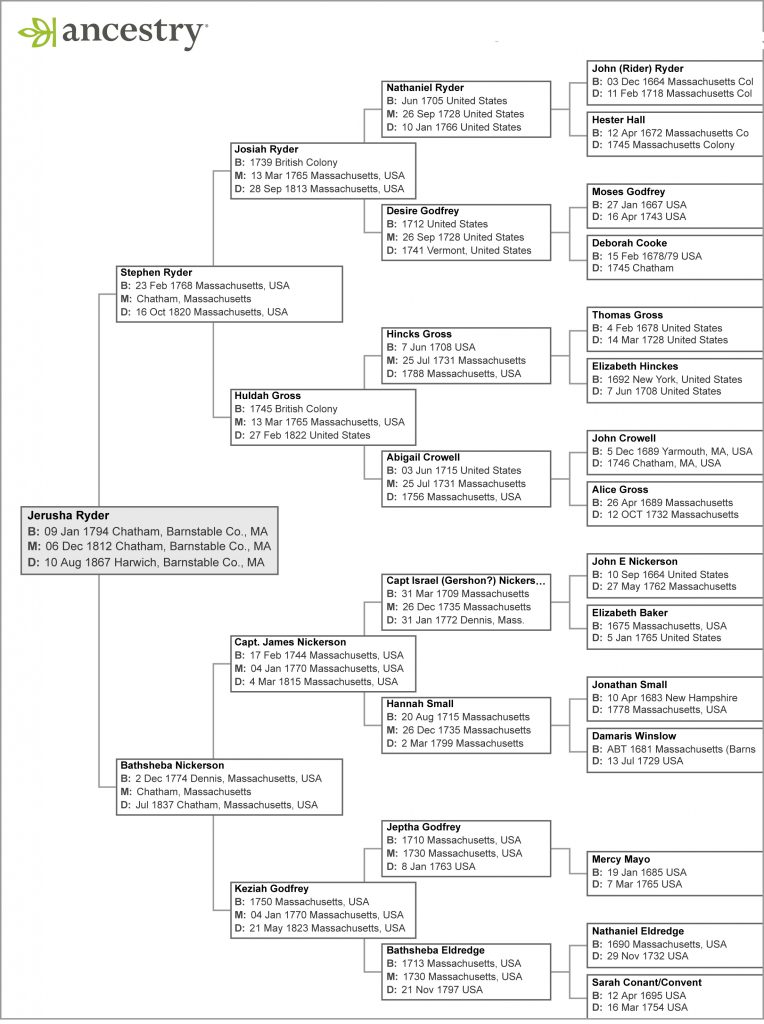
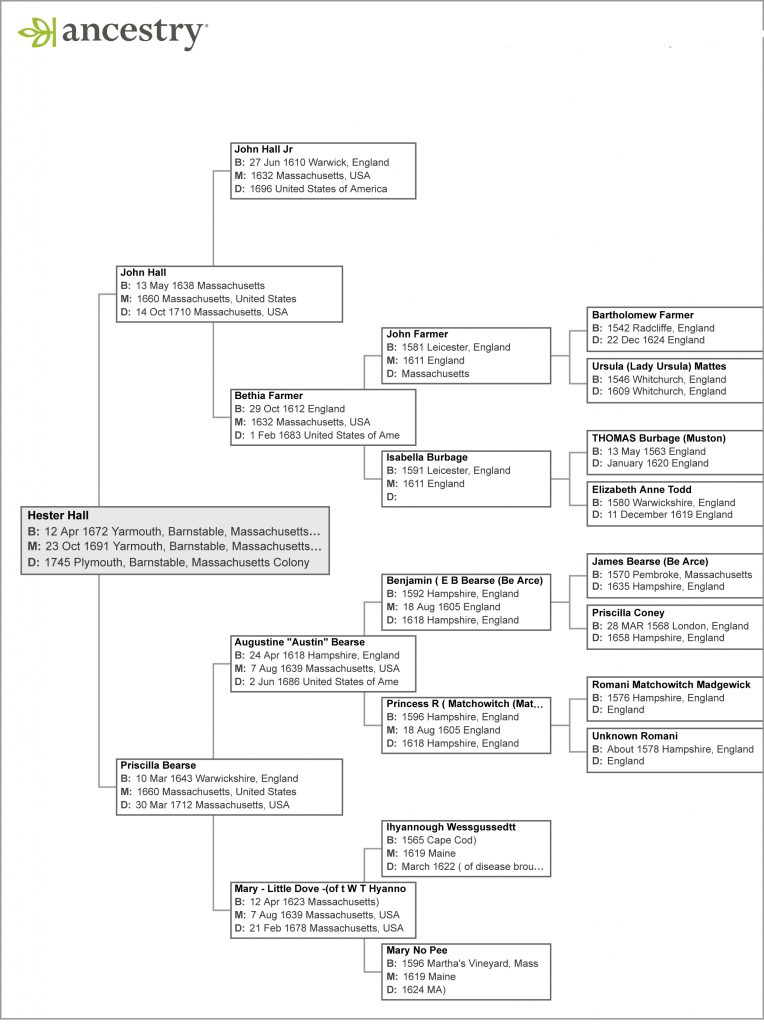
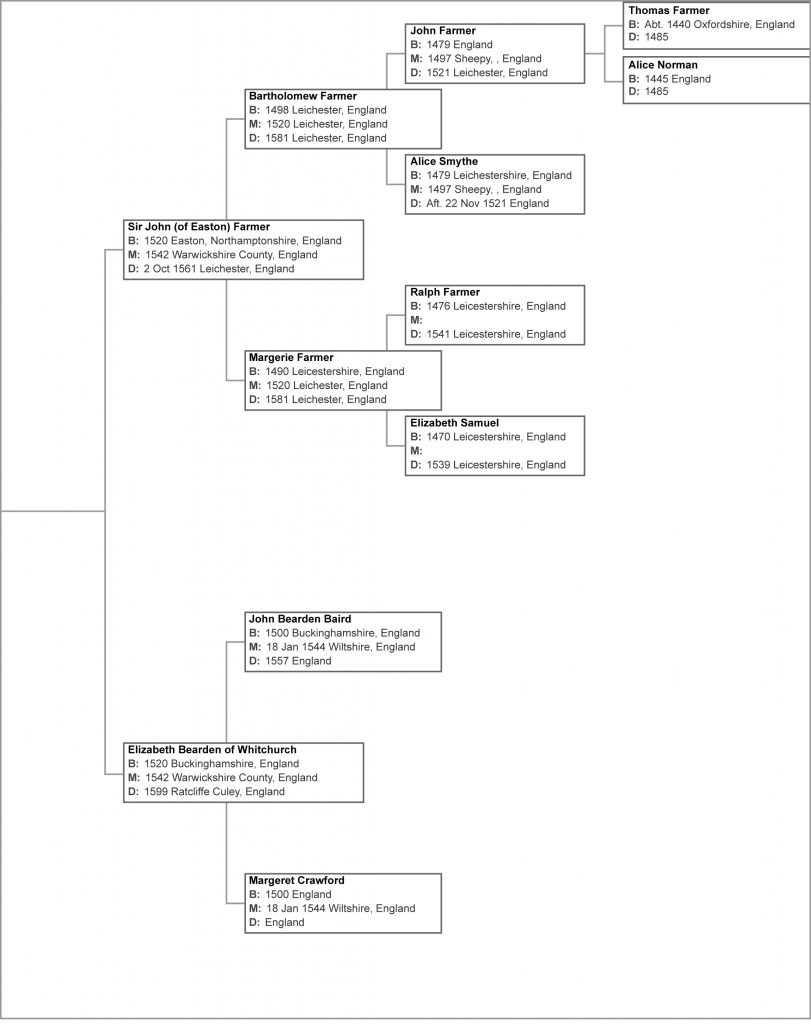
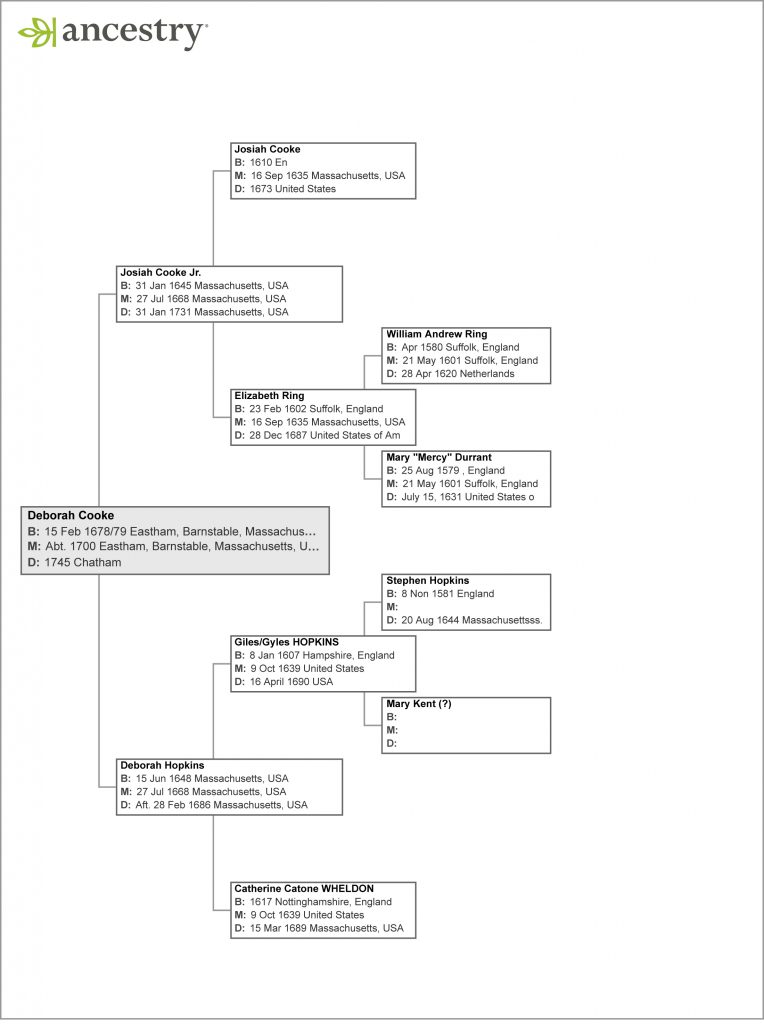
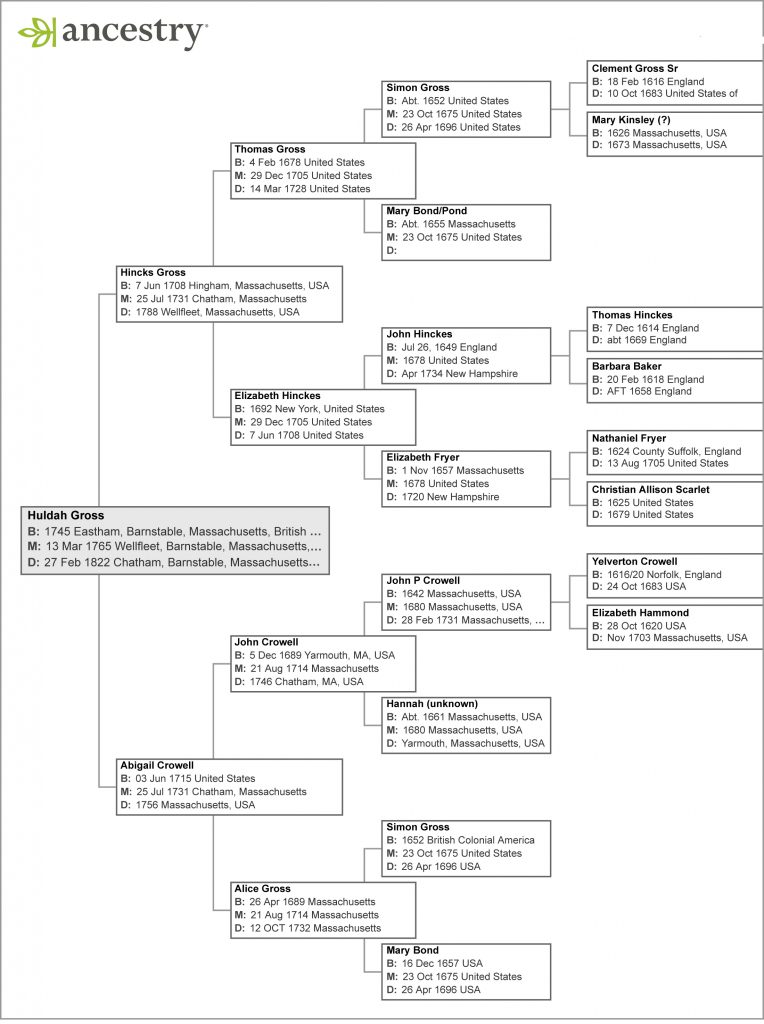
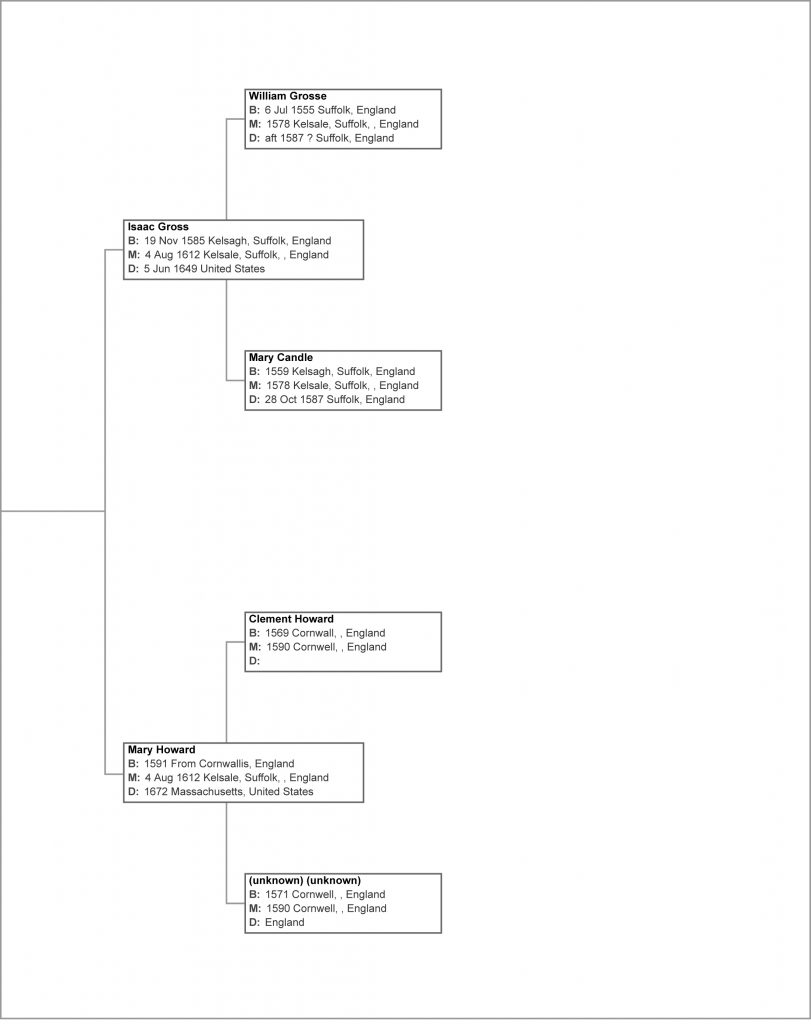
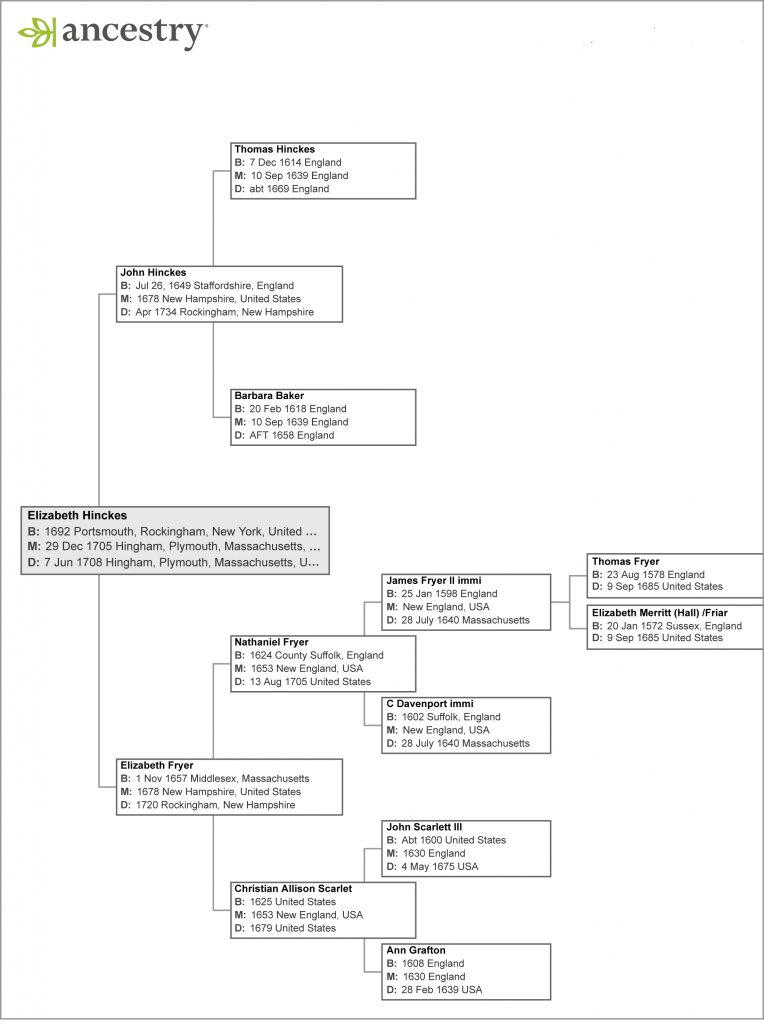
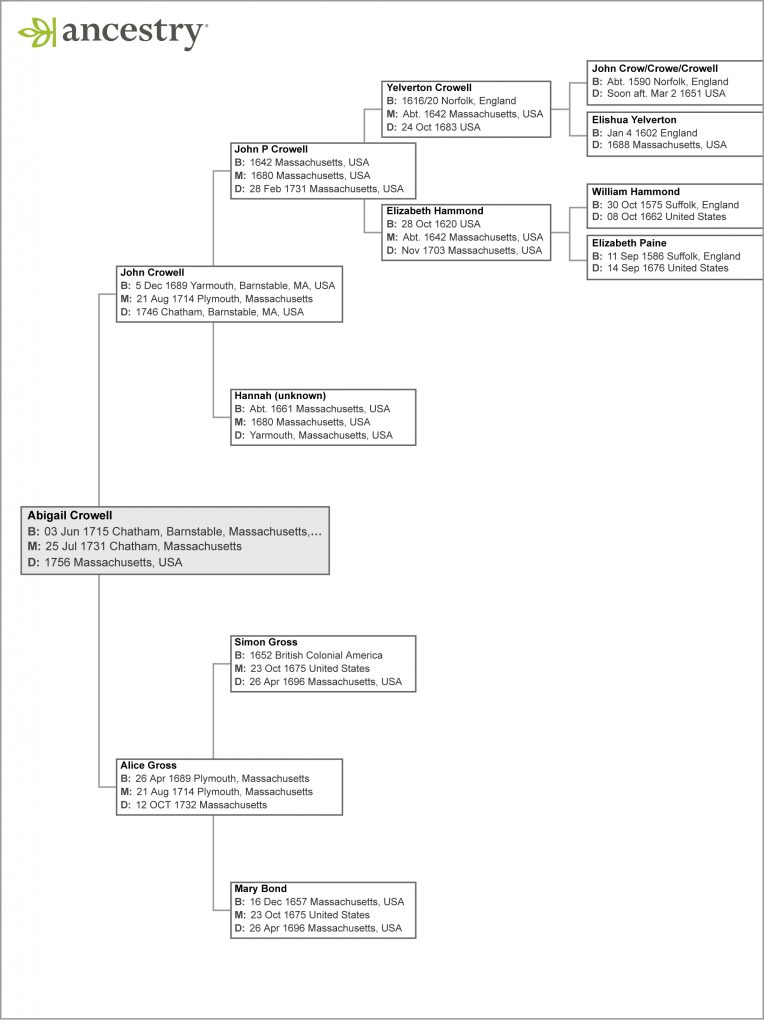
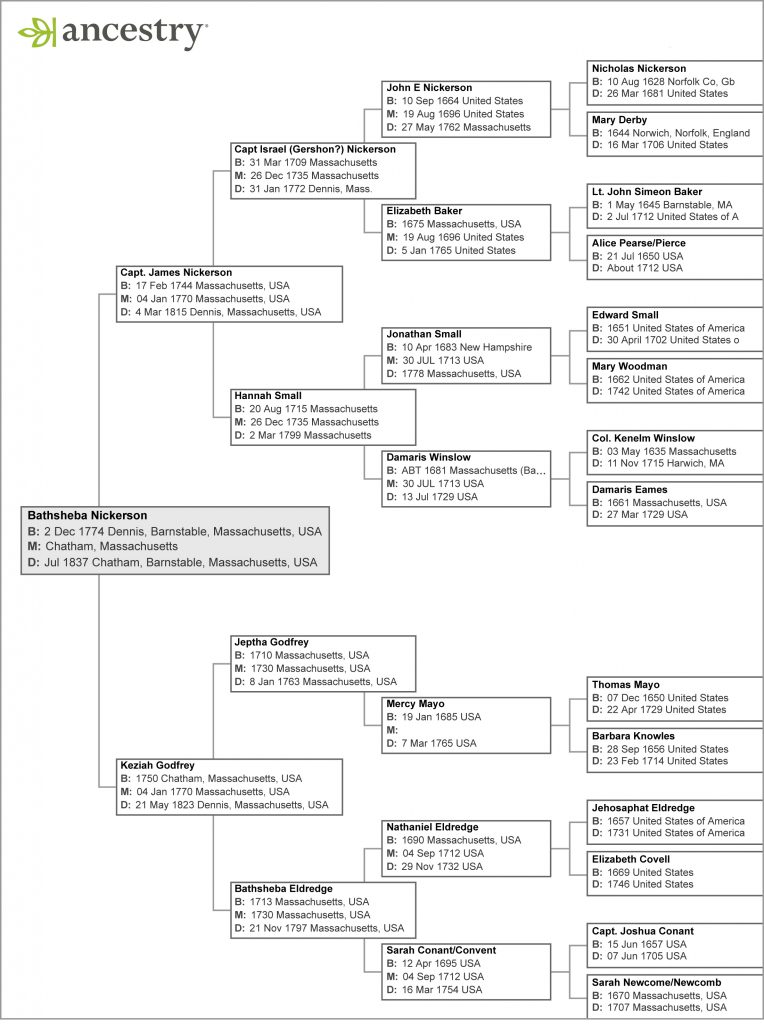
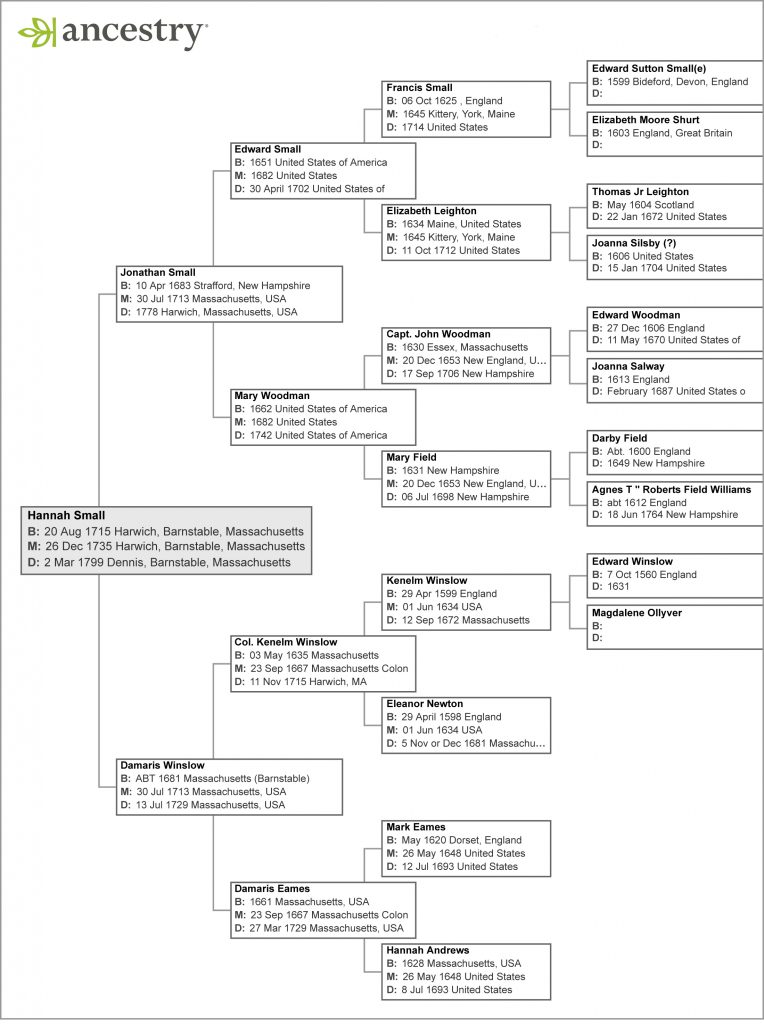
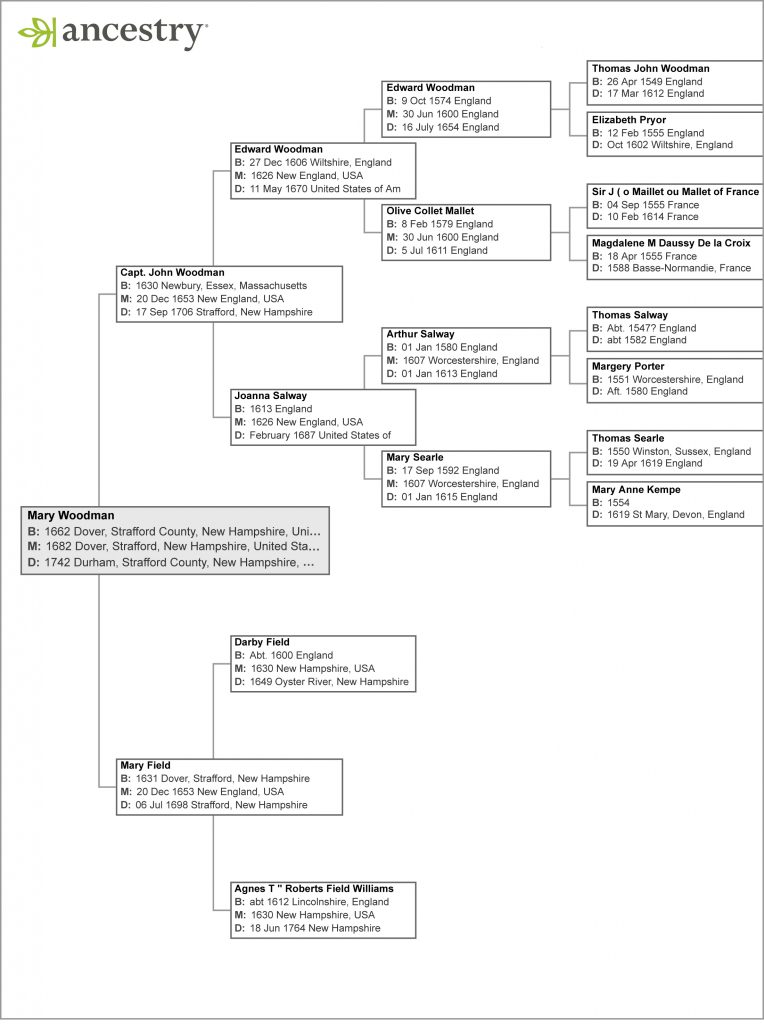




No Responses to “ Ancestors of Jerusha Ryder ”